I was in and around Medellin for more than three months in the end, so it goes to show that first impressions don’t always count (mad cab driver)
The city is amazing! Similar to many others in Latin America it is situated in a bowl and surrounded by mountains but everything here is in perfect proportion. The ratio of the buildings climbing up the mountainside to the expanse of sky and the greenery, the climate which is rarely too hot or too cold and the people are so inquisitively friendly. Also, there is none of the claustraphobia of La Paz or the immense size of Quito. Medellin is perfect.
Medellin was, until relatively recently, the most dangerous city on the planet and whilst it still has its dangers and it can be a bit edgy it has changed rapidly.
The government has initialised what is known as democratic architecture – which is when you take the most dangerous places and rebuild them. The hope is that this reclaims the streets from the criminals, giving people a pride and demonstrating that even the poor areas are worthy of investment. Plaza de Luz used to be a no go area, riddled with crime, drugs and guns but now it is a shining example of opening up a space (although it is still not advisable to visit it at night) with its modern library building and its tall light poles which stalk across the square.
As part of this new development the city is now served by the most fabulous transport system. The metro train sweeps above the city on its concrete piers, a modern cable car serves one of the poorest barrios and whisks you up to Parque Avil and the escaleras electricas have made it easier for the residents in Comuna 13 to connect with the rest of the city. Bizarrely perhaps for us to understand, it is the metro system which symbolises the rebirth of the city from its dark days. You will not find one piece of litter or grafitti on it as the population carefully guard this most iconic representation of progress.
Cultural events abound in parques, and street art and libraries inform and educate. During my time in Medellin I went along to a samba festival which incorporated hip hop and street dance. The energy generated by the samba bands was over and above anything that I have experienced before with their complete love for the rhythms and dance. I went to a tango event, I saw French gypsy music and I watched Brazilian and Argentinian musicians play. I saw most of these events at the cool Centro Plazarte communal space in the rough-around-the edges district of Prado.
There is a entire shopping mall dedicated to geekiness contianing what could be more than two hundred shops selling or repairing mobile phones and computers. I had met G one evening out dancing and when I asked him where I could get my broken laptop fixed he arranged to meet me at the mall and he helped me to negotiate a price and a repair. I believe that the store initially attempted to rip me off by finding a new fault with the computer and charging me nearly four times the original price. After they spotted me taking photographs and learnt that I write for a living they suddenly changed their tune and they couldn’t have been more helpful, keeping my computer for a few days and offering me to lend me one of theirs to take to Cartagena. I tell you this anecdote not to highlight the attempt to scam me but to demonstrate the kindness and generosity of the people. G spent hours with me waiting around, negotiating on my behalf and running me around the city on the back of his motor bike. He had met me once in a night club and simply wanted to help.
Something which makes me chuckle is the pedestianised street in Medellin complete with traffic lights poking up between the crammed market stalls. This street was stealthiliy and illegally claimed by street traders who set up one, two then twenty stalls and by the time the authorities realised that traffic could no longer pass, they couldn’t be bothered to change anything, shrugged and so the street remains.
There is also a large square which contains two of Botero’s sculptures of birds. One is a mess having had a bomb explode next to it during the dark days and the other is a new one which was donated by the artist, although he insisted that the city do not remove the damaged one as a reminder of the high number of lives that were lost at that time.
Like all cities in Colombia prostitutes parade outside one of the main churches, you can buy single cigarettes from traders with their little packed trays and drugs are readily offered as you wander about, but for the most part, everything is conducted under the watchful eye of the ever present police and ususally with a huge smile and good humour
I stayed for the most part in the barrio of Belen in a hostel cum apartment. Rubbing shoulders with backpackers in the dorm, longer stay guests and nomadic workers we shared food and conversations. Travel writers language teachers, musicians and artisans, medical students on a placement, an attorney and a digital marketer all connected and made the place a home from home
I can’t end without mentioning the World Cup. The Colombian team and its supporters won the hearts of the world with their team spirit, salsa dancing and zest for life. I feel extremely priviledged and proud to have been in Colombia during this time when the atmosphere was electric and everybody, including the dogs, wore the gold football shirts
Whilst there was some trouble in some of the big cities on match days and alcohol was subsequently banned it says a lot that Medellin didn’t feel the need to impose such restrictions on its inhabitants.
I watched the Uraquay match in Calle La Setenta where every licor shop, cafe and club had rigged a TV and speaker system outside. The place erupted when Colombia won and the police good naturedly watched while the road was closed to traffic due to the sheer numbers of people celebrating.
The final match against Brazil was AMAZING. A group of us made our way to Parque Lleras in the Poblado district where huge screens had been rigged up among the trees. The place was a sea of yellow with bottles of rum and aguardiente freely passing around. The crowd gradually became a little bit more subdued as it became obvious that Brazil would win and I did wonder what would happen at the final whistle? Anger, fights and trouble? The army and police had a heavy presence and the chances were that things could get ugly.
The final whistle blew and… the place erupted. The Colombians had come out to party and party they would. Proud of their team rather than accusing them for losing they hugged and danced with strangers and celebrated. Music blasted out of houses and bars, drummers drummed and people bought cans of foam and we all had a massive foam fight running around like mad things. The clubs that night were full of gold shirts as the party continued and we stood for nearly half an hour in torrential rain at four in the morning trying to get a cab home.
I adore the city of Medellin.

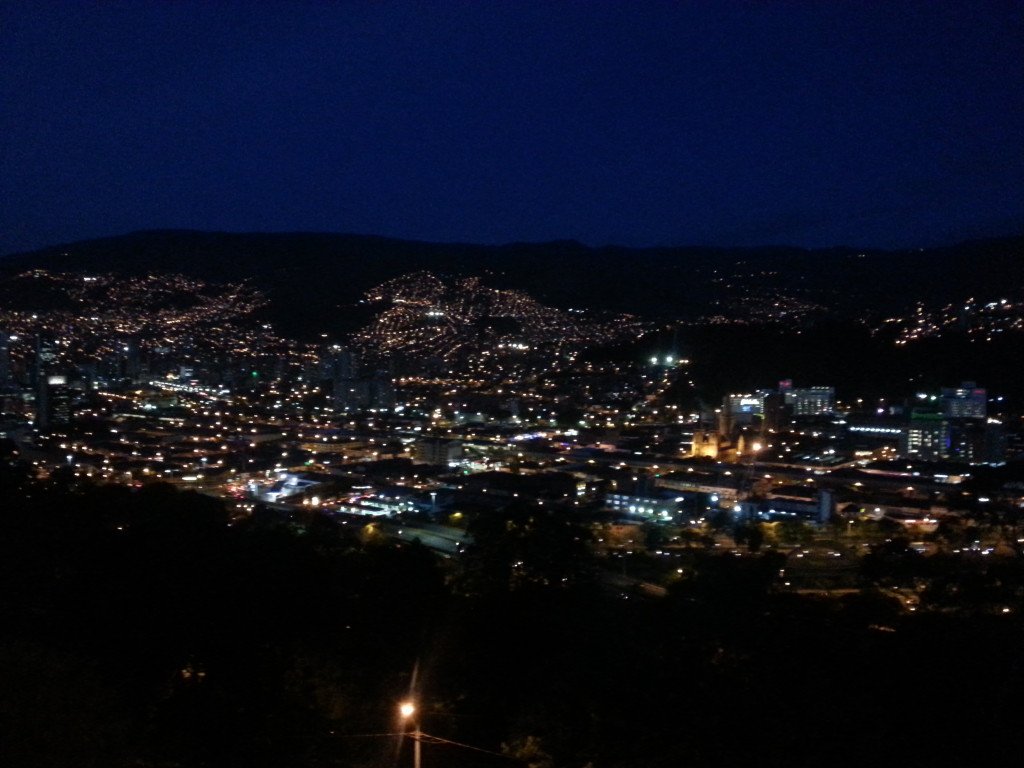



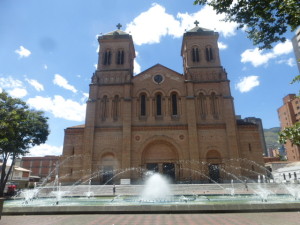
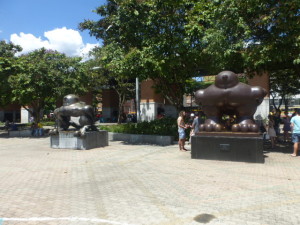
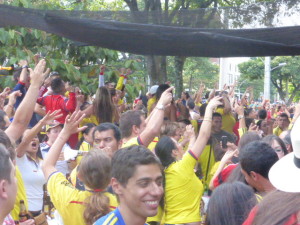
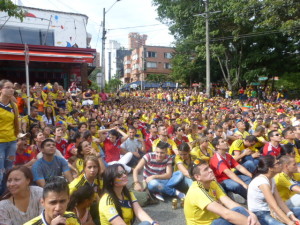
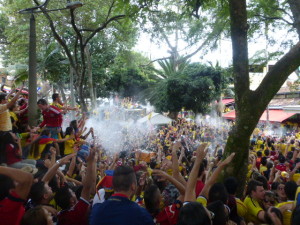
You capture the spirit of a wonderful people who live in a place with perfect weather and wonderful things to see.
A couple of stories to add to yours:
Yesterday we wandered through the metro. Taking trains and cable cars. Whenever we stood on the platform looking around a person in a metro uniform appeared to help us out. One person said — “You don’t have a map?” (The visitor information center in the central square was out.) She proceeded to take a map out of her little pouch, unfolded it and showed us all of the places we were asking about, folded it back up and handed it to us It was clearly her only map, but we needed one, so it was now ours. At another station my partner encouraged me to ask for another map. When we travel and find a good map, we always try to get two — one to carry with us, which generally ends in tatters. Another to take home with us. Once the nice young man understood what we wanted, he took off and motioned me to follow him. He went into a metro office and I could see everyone searching for a map. He came out and motioned me to follow him. He started asking each of his colleagues for a map. One disappeared into another office and emerged with a crisp new map for us. By now several attendants were involved in the map search and they all smiled broadly and wished us a good trip.
We went from train to train and took several cable cars all for one low price. The we got out one cable car and went to the next on ad we were asked to buy another one. This cable car took us up over the jungle. A man in he cable car heard us taking and asked where we were from. He said he was living in Miami for twenty years.
At the top of the trip, we came out onto a big park. As we stood looking around, two people in uniform came to offer us help. We found a little “restaurant” and were trying to figure out what to eat. We saw the man from Miami was standing nearby and he stepped in to help us. He asked how much our lunch was, took out money and paid for it. When we protested he said, “I am so glad you are visiting our country.”
When we came back to our friend where he were staying, he hugged us and said he was so glad we liked his city.
A beautiful place.
Hi Ken, Thank you for adding your wonderful experiences here. This is exactly the sort of attitude that I have met almost everywhere in Colombia and especially Medellin. Yes, parts of the country are still dangerous – for the locals as well as for the tourists, but the friendliness outweighs everything. Just today in Ecuador I met a Colombian policeman who had run for his life with his wife and children after the drug cartels assasinated some of his family a few months ago, but he was STILL smiling and friendly with me. Enjoy the rest of your time there